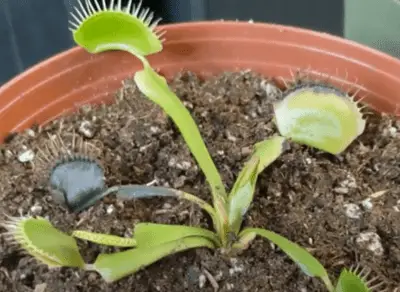Venus fly traps require unique care to live, they won’t usually survive in standard houseplant conditions.
I have grown Venus fly traps for over 5 years and have a method to plant, grow and care for Venus fly traps that ensures success.
Follow the steps below to successfully grow a Venus Fly trap and watch this video to view the process 😉
1- Gather distilled water, carnivorous plant soil, and a plastic pot
Assuming you already have a Venus fly trap, the most common first step is to plant and grow one of these plants is to gather the appropriate materials:
- One gallon of distilled, reverse osmosis or rain water (distilled water is available in grocery stores)
- Carnivorous plant soil: https://amzn.to/3uVbg39
- Tall plastic pot (at least 5 inches in depth): https://amzn.to/34Q6byu
- Small trimmer or scissors: https://amzn.to/3H2mfzZ
Venus fly traps require special water and soil to stay healthy.
The water must be either distilled, reverse osmosis water or rainwater. I recommend distilled water as it is easily accessible in most super markets for one to two dollars a gallon.
One gallon of distilled water will be enough to pot your plant for the first time.
Regarding the potting media, Venus fly traps can’t be planted in standard potting soil, such as potting mixes, cactus soil, succulent soil, etc. Instead, you need to find nutrient-free, mineral free soil. carnivorous plant soil is made up of moss, perlite, and sand, and it is perfect for Venus fly traps.
I have an article where I teach you how to make carnivorous plant soil which you can read. Also, carnivorous plant soil is available for purchase in Amazon for less than 15$, you can use the link to check the current price. One single bag of that mix is usually enough to pot a single plant.
Finally, the pot consideration, Venus fly traps are not too picky regarding the pot. However, it is preferred to use tall containers to promote growth. Also, plastic, glazed ceramic, and Styrofoam containers are the recommended materials.
2.- Remove the Venus fly trap from its original packaging
Most Venus fly traps are sold in very shallow and tiny containers. Those are great for transporting the plants, but not optimal for growing them.
For best results growing your Venus fly trap, you should pot your plant into fresh soil and a larger pot.
Start by removing the fly trap from the soil.
Use the distilled water to moisten the soil slightly. Then, press the pot’s sides at different locations to separate the soil from the pot.
After repeating these actions multiple times you should be able to flip the pot while you hold the Venus fly trap and remove the plant with some of the soil from the pot.
Now your plant is almost ready to be potted and we need to prepare the new container for it.
If you struggle removing the Venus fly trap from the container, use more water and remove some of the soil in the edges to help separate.
3- Moisten the soil and place in the pot
Now, it is time to prepare the container for your plant.
Start by moistening the carnivorous plant soil with distilled water. Moisten the soil until is humid all around.
Then, place the soil inside the container until it is at the desired level.Make sure you have some left over soil to set the plant later on.
Put some slight pressure in the ground to ensure there are no gaps in the soil.
Then, use your finger, or preferably a pen to make a hole in the middle of the pot. The hole should be at least 3/4 of an inch in width.
Here is an example of when I planted a bunch of Venus fly traps in styrofoam cups.
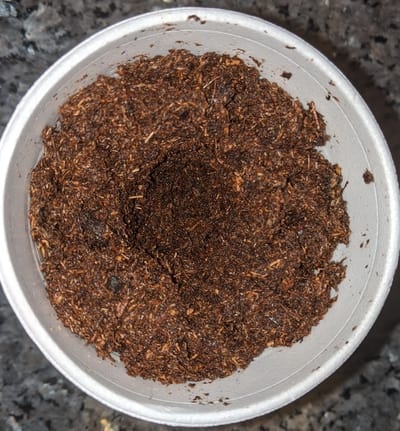
Venus fly traps have very long roots. The hole will ensure they can start expanding vertically from the beginning.
4- Rinse and trim your plant
Before planting your Venus fly trap, take the time to rinse and trim your plant.
Start by using distilled water to rinse the roots and remove any excess soil. There is no need to remove all dirt, but instead focus on larger chucks which will be on the way while planting.
Also, now that your plant is bare root, it is the optimal time to trim the dead leaves.
It is not a requirements, but it does promote growth and makes your plant look great.
I personally use a pair of scissors or tiny trimmer to cut off any black leaves as close to the base as possible.
Here are some of my plants. When I got them they were bare root and I took advantage of that to remove all dead leaves before planting.
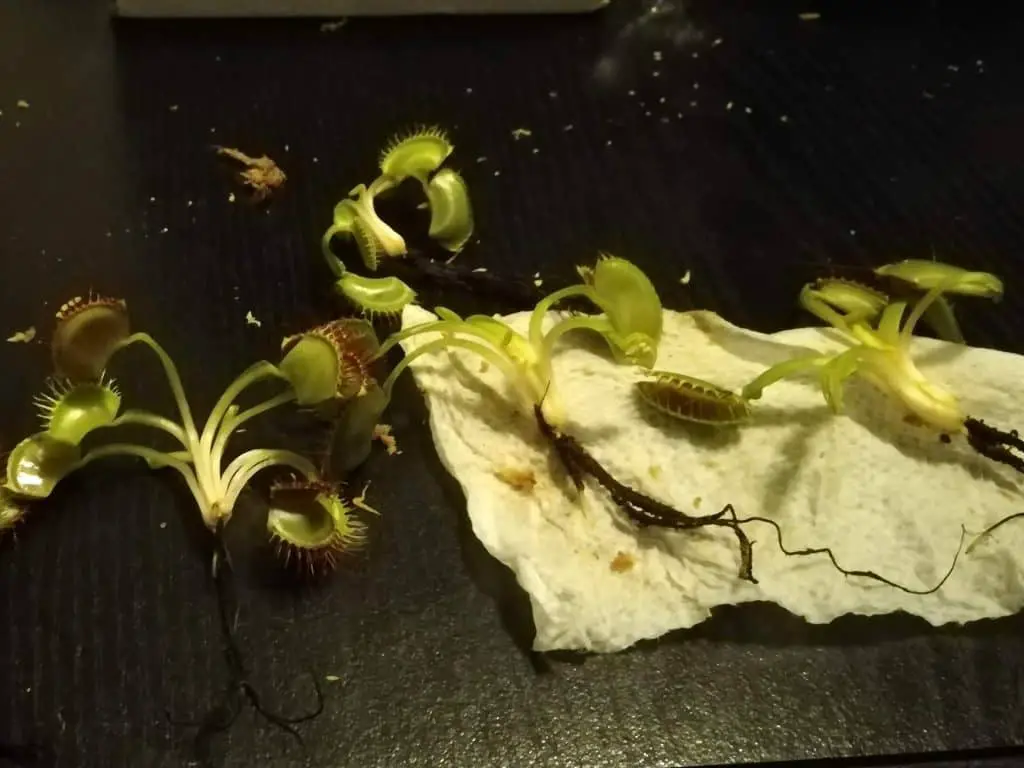
4- Introduce your Venus fly trap into the soil
To plant your Venus fly trap. Start by placing the roots inside the vertical hole in the soil and push the soil together to secure the plant.
The white part of the build should remain underground as the sun will damaged it if exposed.
Here is a picture that help you understand the depth to plant your Venus fly trap.
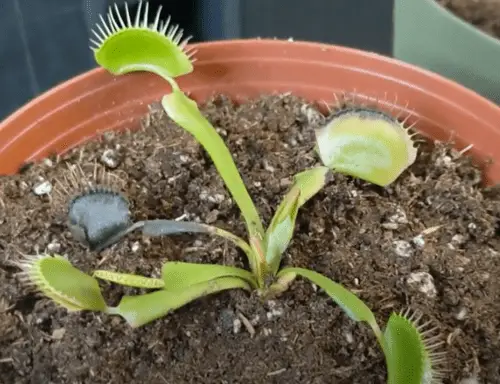
Burry the build, but do not burry the green areas of the plant.
5- Secure your plant into the ground by watering
You might need to use the additional soil you have to set the plant into place. Do it, and ensure there are no holes in the soil left to fill.
After the plant is relatively set into its new media, you must water the plant.
Use the distilled water to water the plant from the top and exert pressure in all the soil throughout.
The water will help compress the soil slightly and secure the plant.
6- Use the water tray method to water perfectly
Venus fly traps require substantial amounts of water to stay healthy.
The soil from a Venus fly trap must be humid at all times and never go dry. However, flooding the soil is not good as it can cause root rot.
To ensure the prefect watering amount at all times, I recommend the water tray method. It is so easy and convenient! 🙂
Place your potted plant inside a tray, it can be standard plant tray or a container that is at least 3 inches in depth.
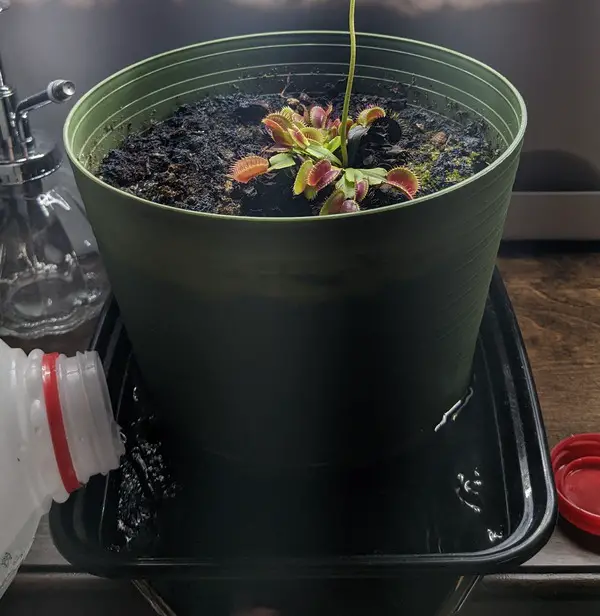
Then, fill up the container with to 2 inches of distilled water. The pot will slowly start absorbing that water from the bottom over the next few days.
Depending on the weather and the size of your plant, such amount of water can last for a few to many days.
The guidance is to refill the water as soon as the tray dries out. Once the tray is dry, refill.
Using this method ensures the soil is humid, never dry and never flooded. Also it promotes root growth.
7- Give your plant a few weeks to acclimate
Now that you plant is potted, it is time to start caring for them.
After repotting, Venus fly traps are often down for a few weeks. During this time, avoid feeding, fertilizing or repotting again. Your plant needs some time to adapt to a new location.
Optimally, Venus fly traps require tons of lighting. However, introducing your plant to bright direct sunlight on day one is not a good practice. The abrupt change can end up killing it.
Instead, introduce your plant to lighting over the course of 2-3 weeks.
Start by placing your plant in a location with 2-3 hours of direct lighting, then increase an hour of direct sunlight every 2-3 days until you get to over 10 hours of light or more.
During the acclimation process, you might notice some leaves turn red, that is a sign you might be going too fast and the leaves are burning due to heat exposure.
When properly acclimated Venus fly traps can withstand bright direct sunlight for 12+ hours in up to 100 F heat.
Here is a complete guide on lighting. Mastering is key to keep your plant healthy.
8- Transition your Venus fly trap to a bright location
Venus fly traps need to live in bright locations to start healthy.
Optimally Venus fly traps need 4-6 hours of direct sunlight to survive. An optimal of 10h hours works best for Venus fly traps.
To ensure success when growing Venus fly traps, ensure you locate a bright location for your plants. It either needs direct sunlight or grow lights.
Indirect sunlight can be a supplement to grow Venus fly trap, but it won’t be enough.
For best results grow Venus fly traps outdoors exposing the plant to 10+ hours of bright sunlight during the growing season. Grow light can also do the trick, but you will need to build a set up.
In this article I explain all you need to know on grow lights and how to use them for carnivorous plants.I have grown Venus fly traps in a small apartment with little to no access to light for a long time. It takes some planning but it is doable.
9- Ensure your plant goes dormant in the winter
During the winter months Venus fly traps go dormant.
It is a process similar to hibernation when the plants look down, lose many of their leaves and rest for a few months. The cold weather and shorter days prompts the plant to go dormant.
Dormancy is critical for Venus flytraps, as they will die if they don’t experience their yearly dormancy.
For that reason it is critical that your plant lives in a cold location during the winter months, where it can experience temperatures below 45F for at least five weeks.
There are also alternate methods to ensure your plant goes dormant, even when a winter climate is not available. You can view my complete guide to dormancy here.
Additional Venus Fly Trap Care Advice
I hope you found this article to be useful. I have a several article on Venus fly trap care, including this complete guide.
Follow the advice below and read the guide to learn more about Venus fly trap care. Happy growing 😀
- Light: Venus flytraps need exposure to plenty of light. Optimally they should receive 12 hours of sunlight, and the minimum is 6 hours of light.
- Watering: Venus flytraps must be watered only with rainwater, distilled water, and reverse osmosis water. The soil of the plant must always remain moist.
- Soil: Employ nutrient-free soil for carnivorous plants. Never employ enriched soil full of fertilizers. This article covers many soil options for Venus flytraps.
- Feeding: Venus flytraps do not need to capture insects to survive, but they benefit from them greatly. This article has a complete list of what you should and shouldn’t feed a Venus fly trap.
- Suitable pots: Do not place Venus flytraps in enclosed containers. Venus flytraps prefer standard plant pots with drainage holes. Depending on the plant’s size, choose a plastic or glazed ceramic container about 2-6 inches in diameter.
- Repotting: repot the plant once a year to avoid soil compression, fungus, and mold.
- Trimming: Remove black leaves once they dry out completely.
- Fertilizers: Do not fertilize Venus flytraps. The chemicals in the fertilizers can hurt the plant.
- Temperature: Keep Venus flytraps in temperatures within this range: 32 F – 95 F (0 C – 35 C). Do not burn them in the summer, and do not let them freeze solid in the winter.
- Dormancy: Venus flytraps must undergo a dormancy period of 2-3 months during the winter. Ensure your plant will experience this yearly resting period by placing them in a cold location.
- Here are some tips on how to grow big venus fly traps.
Recommended Products for Growing Carnivorous Plants
Finding the best pots, lights, and soil for carnivorous plants is difficult. I have grown carnivorous plants for over 5 years, and these are the products I use. The links will take you to Amazon to view the prices and full specs:
- Carnivorous Plant Soil
- Carnivorous plant soil: https://amzn.to/3uVbg39
- Artificial Lighting
- Small plant light for 1-2 plants: https://amzn.to/2RsGlxr
- T8 LED light fixture for multiple plants (6500k Cool White): https://amzn.to/3uWoeh2
- Pots and Miscellaneus
- Nursery pots for single plants: https://amzn.to/34Q6byu
- TDS meter to measure water quality: https://amzn.to/3g8VKLI
- Dried crickets to feed carnivorous plants: https://amzn.to/34QEnKv


